The space shuttle Endeavour linked up with the International Space Station, providing supplies and a new crew – Expedition 5. Docking occurred at 1625 GMT (12:25pm EDT), slightly behind schedule because the shuttle approached the station more slowly than planned.
Hubble’s Infrared Camera Working Again
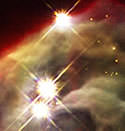
Image credit: Hubble
The Hubble Space Telescope’s Near Infrared Camera and Multi-Object Spectrometer (NICMOS) is functioning again, thanks to the refurbishing it got from a recent space shuttle mission. The telescope’s infrared capabilities ended when the NICMOS ran out of coolant three years ago. To showcase its capabilities, Hubble controllers release a series of images today, including the Cone Nebula – brilliant in infrared.
After more than three years of inactivity, and thanks to a new cryogenic refrigerator, the Hubble Space Telescope’s Near Infrared Camera and Multi-Object Spectrometer (NICMOS) today debuts various breathtaking views of galaxies in several stages of development.
The first NICMOS test images demonstrate its powerful new capability for making remarkable discoveries unique to space-based near-infrared astronomy. The NICMOS’s penetrating vision sliced through the edge-on dusty disk of a galaxy, NGC 4013, to peer all the way into the galaxy’s core. Astronomers were surprised to see what appears to be an edge-on ring of stars, 720 light-years across, encircling the nucleus. Though such star-rings are not uncommon in barred spiral galaxies, only NICMOS has the resolution to see the ring buried deep inside an edge-on galaxy.
Shifting its infrared vision to our stellar backyard, NICMOS peeled back the outer layers of the Cone Nebula (also photographed by Hubble’s Advanced Camera for Surveys in April) to see the underlying dusty “bedrock” in this stellar “pillar of creation.”
“It is fantastic that we have restored Hubble’s infrared eyesight. NICMOS has taken us to the very fringes of the Universe and to a time when the first galaxies were formed. We can’t wait to get back out there,” said Dr. Rodger Thompson, NICMOS Principal Investigator, University of Arizona, Tucson.
Installed on Hubble in February 1997, NICMOS used infrared vision to probe dark, dusty, never-before-seen regions of space with the optical clarity that only Hubble can provide. Its infrared detectors operated at a very cold temperature (minus 351 degrees Fahrenheit, which is minus 213 degrees Celsius or 60 Kelvin).
To keep the detectors cold, NICMOS was encased in a thermos-like container filled with solid nitrogen ice. It was expected that the solid nitrogen ice would last approximately four years. However, the ice evaporated about twice as fast as planned and was depleted after only 23 months of NICMOS science operations. In 1999 ? with its supply of ice exhausted ? NICMOS became dormant.
Determined not to be defeated, NASA scientists and engineers devised a plan to restore NICMOS to life. They turned to a new mechanical cooling technology, jointly developed by NASA and the U.S. Air Force. The NICMOS Cooling System (NCS) was built by NASA’s Goddard Space Flight Center, Greenbelt, MD, and the Creare Corporation, Hanover, NH.
The mechanical cooler operates on principles similar to a modern home refrigerator. It pumps ultra-cold neon gas through the internal plumbing of the instrument. At its core are three miniature, high-tech turbines that spin at rates up to about 430,000 rpm. Since the speed of the turbines can be adjusted at will, the NICMOS light sensors can be operated at a more optimal temperature than was possible before, about 77 Kelvin (minus 321 degrees Fahrenheit).
The NICMOS cooling system is virtually vibration-free, an important aspect for Hubble since vibrations can affect image quality in much the same way that a shaky camera produces blurred pictures.
“The Hubble Space Telescope Servicing Mission 3B is now demonstrated to be a complete success. We had 100 percent servicing mission success, and now we have 100 percent performance success for the newly installed NICMOS Cooling System,” said Dr. Ed Cheng, HST Development Project Scientist from NASA’s Goddard Space Flight Center.
Astronauts installed the NCS inside Hubble during the fifth and final spacewalk of Servicing Mission 3B on March 8, 2002. On March 18, the NCS was turned on via commands sent from the Space Telescope Operations Control Center at Goddard. It has continued to operate flawlessly ever since. The deep interior of the NICMOS reached the target temperature of 70 Kelvin (minus 333 degrees Fahrenheit) on April 11. Most of the internal heat had been removed from the instrument, and the NCS stabilized itself at this temperature. On April 19, NICMOS was brought up to a fully operational state and testing of its internal condition began. Since then, fine adjustments have been made to the settings of the NCS to optimize the instrument for best performance.
Original Source: Hubble News Release
Astronomers Find More Red Quasars
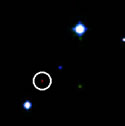
Image credit: NASA
A team of astronomers from the Space believe that red quasars may be more common in the Universe than previously thought. Quasars are bright, distant objects and the current theory is that they are caused by the black holes that reside at the centre of galaxies – because they’re so hot, they usually appear blue. Red quasars are largely obscured by dust and were typically hard to find in visible light, but they can be found in infrared light. The team compared sky surveys in visible and infrared light and turned up 17 of the elusive red quasars.
Elusive red quasars may be more common than previously expected, according to a recent survey conducted by a research team headed by Dr. Mark Lacy, an astronomer at the Space Infrared Telescope Facility Science Center in Pasadena.
The team will display its report on June 3 at the American Astronomical Society meeting in Albuquerque, N.M.
“Every galaxy is thought to have contained a quasar at some point in its lifetime. We wanted a good estimate of the number of quasars existing early in the life of the universe to compare to the numbers of black holes we see in the centers of galaxies today,” Lacy said.
Quasars are thought to be caused by black holes that reside at the centers of galaxies and attract matter from their host galaxies. As the matter falls into the black hole, it heats up and glows brightly, producing a quasar. Because the gas is so hot, many quasars appear very blue in color. Red quasars, however, have smoke-like dust in front of them. This dust absorbs the blue light from the quasar, making it appear redder and fainter than it would otherwise.
Red quasars, which are less common than normal quasars, are difficult to detect because their colors make them hard to distinguish from stars. To find red quasars, Lacy and his team first matched two surveys revealing the positions of existing quasars, among other objects. The two surveys used were the near-infrared Two Micron All-Sky Survey, carried out by the University of Massachusetts and processed at the JPL/Caltech Infrared Processing and Analysis Center in Pasadena, and the Faint Images of the Radio Sky at Twenty-centimeters survey, conducted by R.H. Becker, R.L. White, and D.J. Helfand using the Very Large Array, about 50 miles west of Socorro, New Mexico.
To determine which of the existing quasars were red, the team then used digitized Palomar Observatory sky survey plates, which show images of the sky in visible light. Red quasars were faint or invisible in these plates because of the dust in front of them, but were detected in the infrared. Halfway through their project, Lacy and his team had already found 17 of the reddest quasars known.
“Seventeen is a big number because it implies that there are a lot more red quasars in the universe that we have yet to find,” Lacy said.
Lacy’s team suspects there are many quasars that are even redder than those they observed. They believe these objects, called Quasar-2’s, are just as common as normal quasars. These highly reddened quasars were undetectable through their methods; however, other surveys have reported that they exist.
Lacy co-authored the report with M. Gregg and R.H. Becker, University of California, Davis and the Institute of Geophysics and Planetary Physics Lawrence Livermore National Laboratory, Livermore, Calif.; R.L. White, the Space Telescope Science Institute, Baltimore, Md.; and E. Glikman and D.J. Helfand, Columbia University, New York, N.Y.
The Faint Images of the Radio Sky at Twenty-centimeters survey is supported by the National Science Foundation, Arlington, Va.; the Institute for Geophysics and Planetary Physics Lawrence Livermore National Laboratory; the California Space Institute of the University of California; the Space Telescope Science Institute; Columbia University; Sun Microsystems, Santa Clara, Calif.; the North Atlantic Treaty Organization, Brussels, Belgium; and the National Geographic Society, Washington, D.C.
The Space Infrared Telescope Facility Science Center will handle science operations for the Space Infrared Telescope Facility mission, launching next year. The mission is managed by NASA’s Jet Propulsion Laboratory, Pasadena, Calif., for NASA’s Office of Space Science, Washington, D.C.
Original Source: NASA/JPL News Release
Odyssey Gets More Sensitive
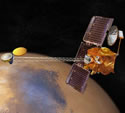
Image credit: NASA
Flight controllers for the Mars Odyssey completed a milestone on Tuesday when they ordered the spacecraft to extend the boom 6.2 metre boom that holds its gamma ray spectrometer sensor head instrument. Even though it hadn’t been deployed yet, the instrument was still able to collect data from Mars’ surface, but this extension will make it much more sensitive. The operation went off without a hitch.
Flight controllers for NASA’s Mars Odyssey spacecraft completed the last major technical milestone today in support of the science mission by unfurling the boom that holds the gamma ray spectrometer sensor head instrument.
Engineers at NASA’s Jet Propulsion Laboratory, Pasadena, Calif., received confirmation from the spacecraft that the 6.2-meter (20-foot) boom was successfully deployed at noon Pacific time.
The gamma sensor head is part of the gamma ray spectrometer suite. It sits at the end of the boom to minimize interference from any gamma rays coming from the spacecraft itself. The two other gamma ray spectrometer instruments, the neutron spectrometer and the high-energy neutron detector, are mounted on the main spacecraft structure.
During the past few months, while the boom was in the stowed position, the instrument suite has provided significant information about the hydrogen abundance on Mars. This allowed scientists to conclude there are large quantities of water ice just below the surface.
“Deploying the boom enhances the sensitivity and accuracy of the gamma ray spectrometer instrument and will improve the accuracy of the hydrogen measurements,” said Dr. William Boynton, principal investigator for Odyssey’s gamma ray spectrometer suite at the University of Arizona, Tucson. Now the instrument will begin measuring many other important elements such as iron, aluminum, potassium, chlorine, thorium, uranium and others.
“Today’s deployment is a continuation of the excellent performance of this flight team. They have done an outstanding job,” said Roger Gibbs, Odyssey’s project manager at JPL. “I look forward to many exciting discoveries to come as we continue our mission.”
JPL manages the 2001 Mars Odyssey mission for NASA’s Office of Space Science, Washington, D.C. Principal investigators at Arizona State University in Tempe, the University of Arizona in Tucson, and NASA’s Johnson Space Center, Houston, operate the science instruments. Additional science investigators are located at the Russian Space Research Institute and Los Alamos National Laboratories, New Mexico. Lockheed Martin Astronautics, Denver, is the prime contractor for the project, and developed and built the orbiter. Mission operations are conducted jointly from Lockheed Martin and from JPL, a division of the California Institute of Technology in Pasadena.
Original Source: NASA/JPL News Release
Ariane Rocket Launches Intelsat Bird
An Ariane 44L rocket successfully launched an Intelsat 905 telecommunications satellite into orbit on Wednesday – liftoff was at 0644 GMT (2:44am EDT) from Kourou, French Guiana. Once in its final position, the Intelsat 905 will provide Ku-band coverage for much of North America and Western Europe. This was the seventh launch of the year for Arianespace.
No More Delays, Endeavour Launches
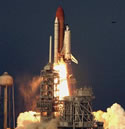
Image credit: NASA
With the weather finally on side for NASA, the space shuttle Endeavour blasted off Wednesday afternoon from Florida’s Cape Canaveral. The shuttle launched at 2122 GMT (5:22 EDT) carrying the crew of Expedition 5 into orbit, bound for the International Space Station. Endeavour will dock with the station on Friday and relieve the 3-man crew of Expedition 4. Shuttle astronauts will also perform 3 spacewalks to install some additional components onto the station.
With improved weather conditions at the Kennedy Space Center, Endeavour lifted off at 4:23 p.m. CDT today, beginning a complex mission to continue the assembly and maintenance of the International Space Station and bring a new trio of residents to the orbital outpost.
Aboard Endeavour are Commander Ken Cockrell, Pilot Paul Lockhart, Mission Specialists Franklin Chang-D?az and Philippe Perrin of the French Space Agency, CNES, along with Expedition 5 Commander Valery Korzun and Flight Engineers Peggy Whitson and Sergei Treschev. As Endeavour launched from Florida, the space station orbited 240 statute miles over the southern Indian Ocean west of Perth, Australia.
Aboard the ISS, Expedition 4 Commander Yury Onufrienko and Flight Engineers Carl Walz and Dan Bursch are wrapping up their 182nd day in space, their 180th day on the station. Walz and Bursch will break the U.S. record for the longest single space flight ? 188 days ? set by astronaut Shannon Lucid in 1996. Another record was equaled today as Chang-D?az became only the second human to fly in space seven times, tying a mark set in April by Jerry Ross on the STS-110 mission.
Less than nine minutes after launch, Endeavour and its crewmembers settled into orbit and work began to prepare the shuttle for its planned 12-day mission.
Endeavour is scheduled to dock to the station Friday afternoon, setting the stage for the handover between the Expedition 4 and Expedition 5 station crews. Three spacewalks are scheduled during the mission by Chang-D?az and Perrin. The first two will help install and activate the Mobile Base System, a platform that will be mated to the Mobile Transporter on the S-Zero (S0) Truss. The new platform will allow the station?s Canadarm2 robotic arm to ?walk off? the Destiny Laboratory onto the Mobile Base System so it can be transported up and down the length of the ISS for future assembly tasks. On the third spacewalk, Chang-D?az and Perrin will replace a faulty wrist roll joint on the station?s robotic arm that has experienced an electrical problem in one of its two data and power channels.
The shuttle crew will go to sleep at 10:23 p.m., and will be awakened at 6:23 a.m. Thursday to begin its first full day in orbit. The next STS-111 mission status report will be issued Thursday morning after Endeavour?s crew is awakened.
Original Source: NASA News Release
Is Life the Rule or the Exception?
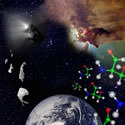
Image credit: ESA
Some scientists have theorized that life on Earth began when amino acids, the building blocks of life, were delivered from space by comets and asteroids. The European Space Agency is planning two missions to help gather more evidence. Rosetta, due for launch in 2003, will study the composition of gas and dust released from a comet to sense what kinds of organic molecules they contain, while Herschel, due for launch in 2007 will focus on the chemistry of interstellar space, searching for traces of the material in distant clouds of dust.
Is life a highly improbable event, or is it rather the inevitable consequence of a rich chemical soup available everywhere in the cosmos? Scientists have recently found new evidence that amino acids, the ‘building-blocks’ of life, can form not only in comets and asteroids, but also in the interstellar space.
This result is consistent with (although of course does not prove) the theory that the main ingredients for life came from outer space, and therefore that chemical processes leading to life are likely to have occurred elsewhere. This reinforces the interest in an already ‘hot’ research field, astrochemistry. ESA’s forthcoming missions Rosetta and Herschel will provide a wealth of new information for this topic.
Amino acids are the ‘bricks’ of the proteins, and proteins are a type of compound present in all living organisms. Amino acids have been found in meteorites that have landed on Earth, but never in space. In meteorites amino acids are generally thought to have been produced soon after the formation of the Solar System, by the action of aqueous fluids on comets and asteroids – objects whose fragments became today’s meteorites. However, new results published recently in Nature by two independent groups show evidence that amino acids can also form in space.
Between stars there are huge clouds of gas and dust, the dust consisting of tiny grains typically smaller than a millionth of a millimetre. The teams reporting the new results, led by a United States group and a European group, reproduced the physical steps leading to the formation of these grains in the interstellar clouds in their laboratories, and found that amino acids formed spontaneously in the resulting artificial grains.
The researchers started with water and a variety of simple molecules that are known to exist in the ‘real’ clouds, such as carbon monoxide, carbon dioxide, ammonia and hydrogen cyanide. Although these initial ingredients were not exactly the same in each experiment, both groups ‘cooked’ them in a similar way. In specific chambers in the laboratory they reproduced the common conditions of temperature and pressure known to exist in interstellar clouds, which is, by the way, quite different from our ‘normal’ conditions. Interstellar clouds have a temperature of 260 ?C below zero, and the pressure is also very low (almost zero). Great care was taken to exclude contamination. As a result, grains analogous to those in the clouds were formed.
The researchers illuminated the artificial grains with ultraviolet radiation, a process that typically triggers chemical reactions between molecules and that also happens naturally in the real clouds. When they analysed the chemical composition of the grains, they found that amino acids had formed. The United States team detected glycine, alanine and serine, while the European team listed up to 16 amino acids. The differences are not considered relevant since they can be attributed to differences in the initial ingredients. According to the authors, what is relevant is the demonstration that amino acids can indeed form in space, as a by-product of chemical processes that take place naturally in the interstellar clouds of gas and dust.
Max P. Bernstein from the United States team points out that the gas and dust in the interstellar clouds serve as ‘raw material’ to build stars and planetary systems such as our own. These clouds “are thousands of light years across; they are vast, ubiquitous, chemical reactors. As the materials from which all stellar systems are made pass through such clouds, amino acids should have been incorporated into all other planetary systems, and thus been available for the origin of life.”
The view of life as a common event would therefore be favoured by these results. However, many doubts remain. For example, can these results really be a clue to what happened about four billion years ago on the early Earth? Can researchers be truly confident that the conditions they recreate are those in the interstellar space?
Guillermo M. Mu?oz Caro from the European team writes “several parameters still need to be better constrained (…) before a reliable estimation on the extraterrestrial delivery of amino acids to the early Earth can be made. To this end, in situ analysis of cometary material will be performed in the near future by space probes such as Rosetta …”
The intention for ESA’s spacecraft Rosetta is to provide key data for this question. Rosetta, to be launched next year, will be the first mission ever to orbit and land on a comet, namely Comet 46P/Wirtanen. Starting in 2011, Rosetta will have two years to examine in deep detail the chemical composition of the comet.
As Rosetta’s project scientist Gerhard Schwehm has stated, “Rosetta will carry sophisticated payloads that will study the composition of the dust and gas released from the comet’s nucleus and help to answer the question: did comets bring water and organics to Earth?”
If amino acids can also form in the space amid the stars, as the new evidence suggests, research should also focus on the chemistry in the interstellar space. This is exactly one of the main goals of the astronomers preparing for ESA’s space telescope Herschel.
Herschel, with its impressive mirror of 3.5 metres in diameter (the largest of any imaging space telescope) is due to be launched in 2007. One of its strengths is that it will ‘see’ a kind of radiation that has never been detected before. This radiation is far-infrared and submillimetre light, precisely what you need to detect if you are searching for complex chemical compounds such as the organic molecules.
Original Source: ESA News Release
Bad Weather Scrubs Endeavour Launch
Stormclouds above Cape Canaveral pushed back the launch of the space shuttle Endeavour on Thursday. NASA meteorologists had been predicting bad weather all week, so the scrub came as no surprise. The launch was pushed back to Friday evening, but even that launch date is at risk, as the stormy weather is expected to last through the weekend. When Endeavour does get into space, it will deliver Expedition 5 to the International Space Station, and return the previous crew back to Earth.
Endeavour Launch Time Announced
Space shuttle managers announced the launch time for mission STS-111 on Wednesday afternoon – Endeavour will launch from Cape Canaveral on Thursday evening at 2344 GMT (7:44pm EDT). Although it was known that the launch was scheduled for Thursday, the exact time was kept secret for security reasons. Endeavour will carry the crew of Expedition 5 to the International Space Station as well as install the new Mobile Remote Servicer Base System. The weather doesn’t look good though, and could very well scrub the launch.
Solar Flare Silences Japanese Mars Probe
A solar flare has struck Nozomi, Japan’s first probe to Mars, cutting off its communications with Earth. Japanese scientists believe that the spacecraft can repair the damage within 6-months, hopefully before it arrives at the Red Planet in December 2003. The solar flare happened over a month ago, but the damage to the spacecraft was only recently admitted to the public. Nozomi will study Mars’ upper atmosphere and magnetic field.
